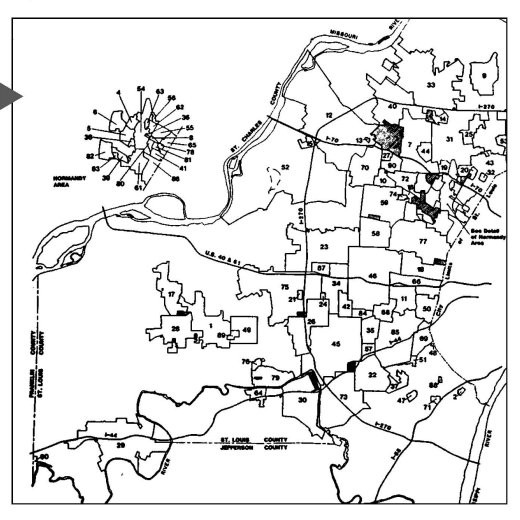The Ten Failures discussed by Gerckens:
- The Demise of Community-Oriented Design & Development
- The Lost Vision of Regional Planning
- The Fragmented Nature of Metropolitan Governance
- The Unfulfilled Promise of High Tech Housing
- The Landscape of Racial and Economic Segregation
- Disinvestment in Public Transit
- Defaulting on the Promise of Public Housing
- Abandonment of the Quest for a “Great Society”
- Narrowing the Mission of HUD
- Comprehensive Planning Constrained …
Read an excerpt from this article below. You can download the full article by using the link at the end of the excerpt.
One of the failures Gerckens’ discusses, the fragmented nature of metropolitan governance, can be seen in this view of municipal jurisdictions in the St. Louis metro area.

According to a report of St. Louis 2004, a non-profit organization promoting regional cooperation, St. Louis ranked fifth (in 1992) among America’s thirty-five largest metro areas, in number of government units with 771.
As Gerckens’ writes:
Laws empowering individual communities to plan and act to fulfill their own definitions of the public interest might well have made sense at the beginning of the twentieth century when urban settlements were small and isolated from one another. But such “home rule,” when engaged in by a plethora of communities within a metropolitan area, led to the failure to address pressing area-wide issues.
Perhaps the most telling case-in-point was the failure of school desegregation efforts. These efforts failed, in large part, because the unit dealt with was the individual segregated school district and not the metropolitan region. One could flee from the once segregated central school district to an all-white suburban school district with impunity. This “white flight” contributed to intensification of the racial and economic separation of the central city and its surrounding suburbs.
But school desegregation was just one of a cluster of issues — including affordable housing, public transportation, water quality, solid waste, and more — not effectively dealt with largely because of the fractured nature of metropolitan governance.
Early efforts toward metropolitan governance, such as the consolidation of the City of Nashville and Davidson County, Tennessee in 1962, were met with vehement denunciations elsewhere as an “un-American” attack on local democratic government. But as the impacts of unchecked metropolitan expansion became more apparent in increased costs, functional duplication, and inefficiencies, interest in metropolitan government increased.
The formation of metro governments in places like Nashville, Indianapolis, Miami, and Toronto, however, is still the exception rather than the rule. The need to address the failure of effective metropolitan governance remains high on the list of America’s challenges as we enter the new millennium.
End of excerpt